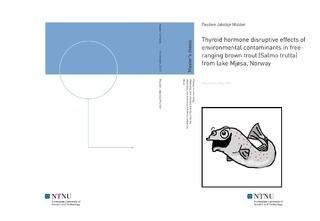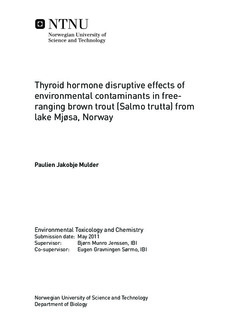| dc.description.abstract | VBrown trout (Salmo trutta) from Lake Mjøsa, Norway, contain very high levels of polybrominated diphenyl ethers (PBDEs), in addition to elevated levels of other persistent organic pollutants (POPs) and trace metals, including mercury (Hg). By contrast, the levels of Se in brown trout are low. This study investigated whether the plasma thyroid hormone (TH) levels of free-ranging trout in Lake Mjøsa were affected by the various contaminants and oxidative stress. Both plasma thyroxine (T4) and triiodothyronine (T3) levels were affected by the contaminants investigated. Selenium variables in muscle were positively correlated with both TT3 and the total to free T3 (TT3:FT3) ratio, where the Se:Hg molar ratio was the best predictor of TT3, and Se was the best predictor of TT3:FT3. The Se:Hg ratio in muscle tissue also was an important predictor of total T4, and a weaker predictor of FT4 levels in the trout. Furthermore, Hg alone also correlated negatively with several T4 variables. It is suggested that Se acts as an antagonist against Hg induced TH disruptive effects, and that trout from Lake Mjøsa may be susceptible to effects due to low Se levels in the lake. Hepatic concentration of several heavy metals, especially cadmium and chromium, were also negatively related to T3 levels. Plasma THs were not well correlated with the POPs, but weak negative effects on TT4 and total to free T4 (TT4:FT4) were observed for several PBDEs and polychlorinated biphenyls (PCBs). Biomarkers of increased hepatic oxidative stress (the glutathione system) were not linked to depleted TH levels, but associated with bioavailability of Se, which likely accounted for the positive correlation between oxidized glutathione and T3 in the trout. Since relationships between THs and trace elements were stronger than relationships between THs and POPs, it is suggested that measurements of both POPs and trace elements should be included in studies that aim to investigate TH disruptive effects in free-ranging freshwater fish. | nb_NO |

